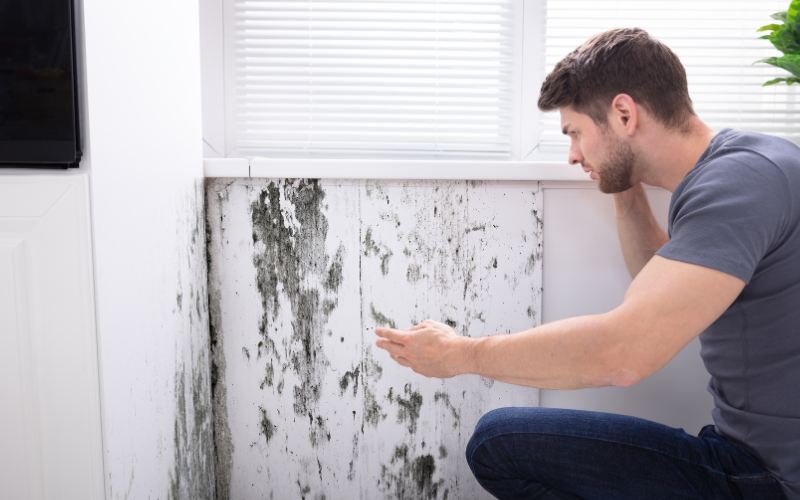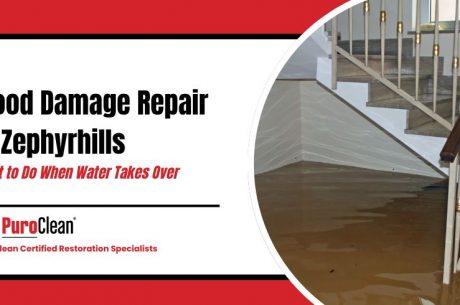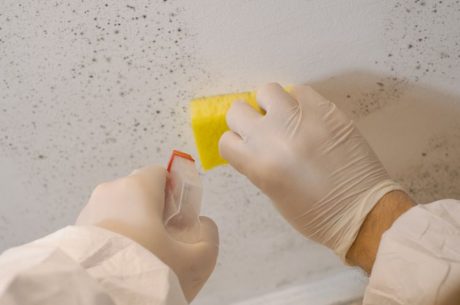
Image by AndreyPopov from Getty Images on Canva
Mold and mildew are common household nuisances that many people encounter but often struggle to differentiate. If you’ve ever wondered, what is the difference between mold and mildew, you’re not alone. These fungi thrive in damp environments, causing not only unsightly stains but also potential health concerns. Their distinct characteristics make identifying and addressing them a crucial step in maintaining a safe and healthy home.
In this guide, we’ll explore how these two fungi vary in appearance, texture, and impact, offering insights to help you identify and manage them effectively. While mildew is often easier to clean, mold can lead to more serious structural and health problems. For persistent issues, professional mold remediation may be necessary.
What Is Mold?
Mold is a type of fungus that grows in multicellular structures called hyphae, forming visible colonies. It thrives in damp, humid, and warm environments, often appearing as fuzzy or slimy patches in shades of green, black, white, or other colors. Mold reproduces through lightweight spores that can spread through the air, settling on surfaces where moisture is present. Common indoor sources include leaky pipes, damp basements, or poorly ventilated bathrooms. Prolonged exposure to mold can cause respiratory issues, allergic reactions, and structural damage to buildings.
What Is Mildew?
Mildew is a type of fungus closely related to mold that primarily grows on flat, moist surfaces. Unlike mold, mildew is usually white or gray and has a powdery texture. It thrives in warm, damp environments, such as bathrooms, kitchens, or outdoor plants. Mildew is often associated with surface-level growth and is easier to clean than mold. While less severe than mold, mildew can still cause respiratory irritation or allergies if left untreated. Routine cleaning and proper ventilation can help prevent mildew from forming indoors.
What Is the Difference Between Mold and Mildew
There are several key differences between mold and mildew, although people often use the terms interchangeably. These distinctions are important for identifying and addressing specific issues in homes or buildings. Mold and mildew differ in appearance, growth patterns, effects, and more.
1. Appearance
Mold and mildew look different when they grow. Mold often appears as fuzzy or slimy patches in colors like black, green, or yellow. It tends to grow in irregular, uneven patterns. Mildew, on the other hand, appears flat and powdery, usually in shades of white, gray, or light yellow. Mildew spreads in a more uniform pattern, often resembling a fine layer of dust. Recognizing these visual differences can help in correctly identifying the issue and determining the best course of action for removal or treatment.
2. Growth Locations
Mold and mildew prefer different environments. Mold thrives in damp, dark, and humid spots such as basements, crawl spaces, and behind walls. It often grows on organic materials like wood, paper, or fabric. Mildew, in contrast, is more likely to grow on the surface of materials in moist areas with less humidity, such as shower walls, windowsills, or bathroom tiles. Understanding these preferred growth locations can help prevent these fungi from taking hold by addressing specific environmental conditions.
3. Texture
The texture of mold and mildew sets them apart. Mold is often thick and can feel slimy or fuzzy to the touch, depending on its type and growth stage. Its texture varies based on the materials it grows on. Mildew, however, is lighter and feels more powdery or chalky. These texture differences are especially noticeable when attempting to clean or remove them. Mildew tends to come off surfaces more easily, while mold may require more effort and specialized cleaning solutions.
4. Health Effects
Both mold and mildew can impact health, but mold typically poses a more significant risk. Mold can cause severe respiratory issues, allergies, asthma attacks, and long-term health problems if exposure is prolonged. Toxic black mold can produce harmful mycotoxins, which may lead to serious illnesses. Mildew, while less harmful, can still cause respiratory irritation, especially for individuals with allergies or sensitivities. Knowing these health effects helps prioritize mold removal over mildew when both are present in a home or building.
5. Odor
The smell of mold and mildew differs noticeably. Mold emits a strong, musty odor that is often described as earthy or damp. This pungent smell can linger and worsen over time. Mildew, on the other hand, has a lighter, less intense odor, often compared to damp laundry. While mildew’s odor may be unpleasant, it is typically less overpowering. Identifying the type of smell in your home or workplace can provide a clue as to which of these fungi you are dealing with.
6. Cleaning and Removal
Mildew is generally easier to clean and remove than mold. Mildew often resides on surface layers and can be wiped away using household cleaners or simple scrubbing. Mold, however, often penetrates deeper into materials and requires professional remediation for complete removal. Mold can damage building structures and personal belongings if left untreated. Using the right cleaning method for each can save time, money, and prevent further growth. Mold remediation often involves more extensive measures to fully eradicate the problem.
Frequently Asked Questions

Image by Coja1108 from Getty Images on Canva
How can I tell if a smell is caused by mold or mildew?
Mold usually emits a strong, earthy, musty odor, while mildew has a lighter, damp smell often resembling stale laundry. If the smell is intense and persistent, it’s likely mold. Identifying the odor type can guide you in determining the necessary steps for cleaning or professional assistance.
Is mildew more common in outdoor or indoor environments?
Mildew is common in both settings but often grows outdoors on plants, leaves, and soil where moisture is present. Indoors, it thrives on moist surfaces like tiles, windowsills, or shower walls. Proper ventilation and reducing humidity indoors can help limit mildew growth.
What is the difference between mold and mildew when it comes to their ability to spread?
Mold spreads aggressively through airborne spores that settle on damp surfaces, leading to widespread and deep-rooted growth. Mildew, in contrast, is less invasive and typically remains on surface layers, making it easier to remove. Promptly addressing mold is crucial as it can infiltrate walls and furniture, causing extensive damage.
What is the difference between mold and mildew in terms of their impact on indoor air quality?
Mold significantly deteriorates indoor air quality by releasing spores and mycotoxins that can cause respiratory issues and allergic reactions. Mildew has a lesser impact but can still irritate sensitive individuals. Proper ventilation and air purifiers help manage both, but mold often requires professional remediation for lasting improvement in air quality.
Conclusion
Understanding what is the difference between mold and mildew is crucial for maintaining a safe, healthy home. While mildew is easier to manage, mold poses greater risks to your health and property. Regular cleaning, proper ventilation, and addressing damp areas can help prevent both. For persistent mold issues, seeking professional assistance is essential to ensure complete removal and prevent recurrence.
If you’re dealing with mold in your home, trust PuroClean Zephyrhills for expert remediation services. We specialize in removing mold effectively, ensuring your property is safe and healthy. Contact us today to schedule a consultation and take the first step toward a mold-free environment.




 PuroClean Certified Restoration Specialists
PuroClean Certified Restoration Specialists